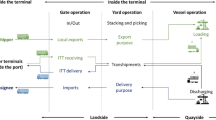Abstract
Emissions from idle truck engines are a main source of pollution at container terminals. In this study, we focus on reducing such emission from waiting trucks as well as the related crane operations with a new truck arrival control method that gives individual truck limited time slots for entry. We develop a method to optimize the time slot assignment for individual trucks, aiming at minimizing total emissions from trucks and cranes at import yards. The method applies discrete event simulation to estimate total truck waiting times and crane moving distance, and then applies a genetic algorithm to minimize the generated emissions from these trucks and cranes. The experiment result shows that the truck arrivals should be controlled based on the stacking of import containers, and that such control is necessary for reducing truck idling emissions at a congested container terminal.





Similar content being viewed by others
References
Brodrick, C. J., Lipman, T. E., Farshchi, M., Lutsey, N. P., Dwyer, H. A., Sperling, D. et al. (2002). Evaluation of fuel cell auxiliary power units for heavy-duty diesel trucks. Transportation Research Part D, 7, 303–315.
Chen, G., Govindan, K., & Golias, M. M. (2013a). Reducing Truck emissions at container terminals in a low carbon economy: Proposal of a queueing-based bi-objective model for optimizing truck arrival pattern. Transportation Research Part E, 55, 3–22.
Chen, G., Govindan, K., & Yang, Z. Z. (2013b). Managing truck arrivals with time windows to alleviate gate congestion at container terminals. International Journal of Production Economics, 141, 179–188.
Chen, G., Govindan, K., Yang, Z. Z., Choi, T. M., & Jiang, L. (2013c). Terminal appointment system design by non-stationary M(t)/Ek/c(t) queueing model and genetic algorithm. International Journal of Production Economics, 146, 694–703.
Chen, X., Zhou, X., & List, G. F. (2011). Using time-varying tolls to optimize truck arrivals at ports. Transportation Research Part E, 47, 965–982.
Drewry Shipping Consultants, Ltd. in 2010, http://seekingalpha.com/article/262778-2-charts-showing-the-global-economy-is-recovering.
Geerlings, H., & Duins, R. V. (2011). A new method for assessing CO\(_{2}\)-emissions from container terminals: A promising approach applied in Rotterdam. Journal of Cleaner Production, 19, 657–666.
Gen, M., & Cheng, R. (1999). Genetic algorithms and engineering optimization (1st ed.). New York: Wiley.
Giuliano, G., & O’Brien, T. (2007). Reducing port-related truck emissions: The terminal gate appointment system at the ports of Los Angeles and Long Beach. Transportation Research Part D, 12(7), 460–473.
Goldberg, D. E. (1989). Genetic algorithms in search, optimization and machine learning (1st ed.). New York: Addison-Wesley Publishing Company.
Golias, M., Boilé, M., Theofanis, S., & Efstathiou, C. (2010). The berth scheduling problem: Maximizing berth productivity and minimizing fuel consumption and emissions production. Transportation Research Record, 2166, 20–27.
Goodchild, A., & Mohan, K. (2008). The clean trucks program: Evaluation of policy impacts on marine terminal operations. Maritime Economics & Logistics, 10(4), 393–408.
Guan, C. Q., & Liu, R. f. (2009). Container terminal gate appointment system optimization. Maritime Economics & Logistics, 11(4), 378–398.
Huynh, N. N. (2009). Reducing truck turn time at maritime container terminals with appointment scheduling. Transportation Research Record, 3230, 48–56.
Huynh, N., Harder, F., Smith, D., Sharif, O., & Pham, Q. (2011). Truck delays at seaports—Assessment using terminal webcams. Transportation Research Record; Journal of the Transportation Research Board, 2222, 54–62.
Huynh, N., Walton, C. M., & Davis, J. (2004). Finding the number of yard cranes needed to achieve desired truck turn time at marine container terminals. Transportation Research Record, 1873(1), 99–108.
Lam, S. F., Park, J., & Pruitt, C. (2007). An accurate monitoring of truck waiting and flow times at a terminal in the Los Angeles/Long Beach Ports - METRANS Project AR 05–01. Long Beach: The METRANS Transportation Center.
Larson, R. C., & Odoni, A. R. (1981). Urban operations research Chapter 4, pp. 249–251. New Jersey: Prentice-Hall.
Meyer, P. D., Maes, F., & Volckaert, A. (2008). Emissions from international shipping in the Belgian part of the North Sea. Atmospheric Environment, 42, 196–206.
Ozbay, K., Yanmaz-Tuzel, O., & Holguín–Veras, J. (2006). The impacts of time-of-day pricing initiative at NY/NJ port authority facilities car and truck movements. Transportation Research Record; Journal of the Transportation Research Board, 1853, 48–56.
Pachakis, D., Fidell, T., McNally, J., Nye, L., (2008). Achieving emission reductions in container terminals through process change. Harbours, Air Quality and Climate Change (HAQCC 2008) Conference. Netherlands: Rotterdam.
Saxe, H., & Larsen, T. (2004). Air pollution from ships in three Danish ports. Atmospheric Environment, 38, 4057–4067.
Starcrest Consulting Group, L. (2011). The Port Of Los Angeles Inventory of Air Emissions For Calendar Year 2010. Los Angeles: Port of Los Angeles.
Tzannatos, E. (2010). Ship emissions and their externalities for the port of Piraeus. Atmospheric Environment, 44, 400–407.
Zietsman, J., Farzaneh, M., Schneider-IV, W. H., Lee, J. S., & Bubbosh, P. (2009). Truck stop electrification as a strategy to reduce greenhouse gases, fuel consumption and pollutant emissions. Transportation Research Board Annual Meeting 2009. Washington DC: Transportation Research Board.
Author information
Authors and Affiliations
Corresponding author
Rights and permissions
About this article
Cite this article
Do, N.A.D., Nielsen, I.E., Chen, G. et al. A simulation-based genetic algorithm approach for reducing emissions from import container pick-up operation at container terminal. Ann Oper Res 242, 285–301 (2016). https://doi.org/10.1007/s10479-014-1636-0
Published:
Issue Date:
DOI: https://doi.org/10.1007/s10479-014-1636-0




